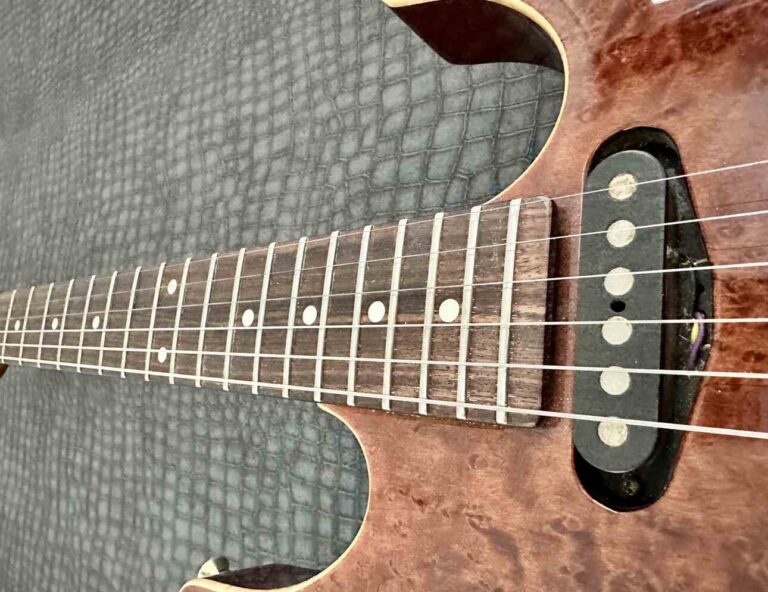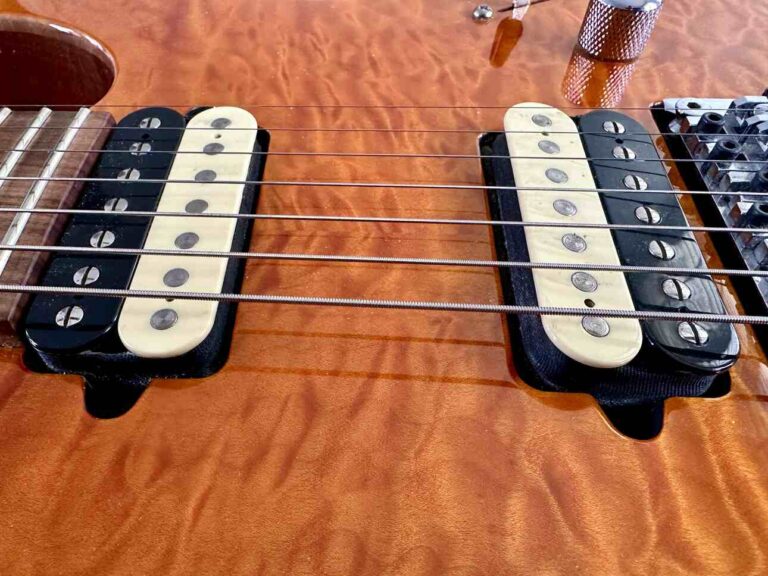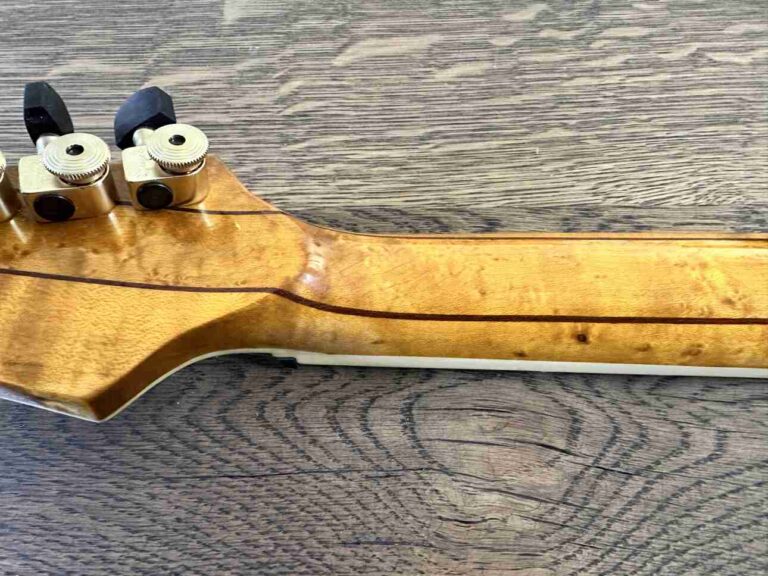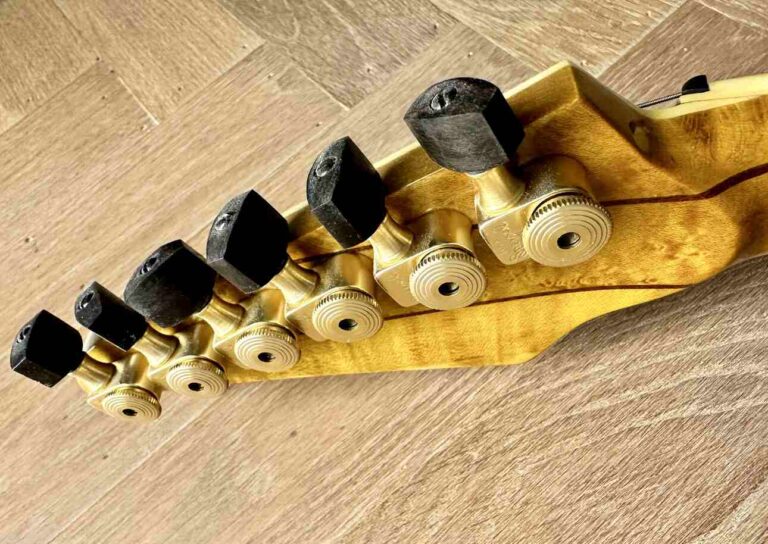What’s The Green Stuff on My Guitar Frets? Just Clean and Polish

Key Takeaways
- The green stuff on guitar frets results from oxidation and dirt accumulation;
- Proper cleaning can help remove the buildup and keep your frets in top shape;
- Stick to a regular cleaning routine and safeguard your guitar against the elements.
Understanding the Green Stuff on Guitar Frets
What Is Verdigris?
That green tint on your guitar frets? That’s verdigris – a sign of copper, brass, and bronze metal corrosion.
This happens when these metals meet air and moisture over time. Verdigris is a telltale sign that corrosion has set in for guitar frets. It’s often made from a blend of copper, zinc, and sometimes nickel (known as fretwire).
Common Causes of Fret Corrosion
- Humidity and moisture are the main culprits behind fret corrosion. Playing your guitar, your fingers can leave sweat on the frets. This may lead to chemical reactions that cause corrosion. That’s why wiping down your guitar after playing is as important as storing it in a place with controlled humidity;
- Your playing environment can also affect your guitar’s frets. This is especially true if you play outside. The varied temperatures, humidity, and pollutants outdoors can speed up the formation of verdigris. Aim to keep your guitar in a stable environment. Use a humidifier or dehumidifier to keep the humidity levels just right;
- Neglecting proper maintenance can invite fret corrosion. Regular cleaning is key to preserving your guitar. Use a soft cloth to wipe down your guitar. Consider using specialized guitar cleaners or oils when necessary.
A small amount of verdigris on your frets might not immediately affect your playing. However, leaving it unaddressed can lead to issues like fret pitting or structural damage.
Check your guitar regularly for signs of corrosion. Clean it regularly to keep your frets in tip-top shape. Proper care lets you keep the green stuff at bay and enjoy a well-maintained guitar.
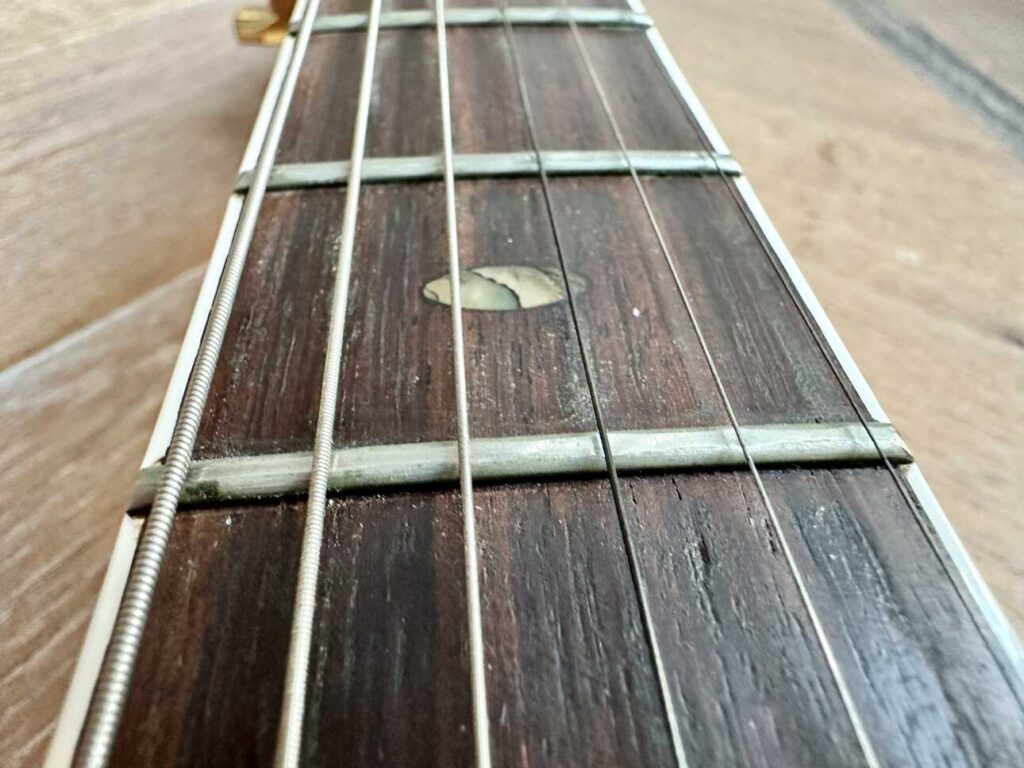
Step-by-Step Guide to Cleaning Guitar Frets
Materials Needed for Cleaning
To begin cleaning your guitar frets, you’ll need the following things:
- A soft cloth (microfiber is preferred)
- A small brush (an old toothbrush will work)
- Guitar cleaner or mild soap
- Guitar fretboard oil
- Fine steel wool (if necessary)
Removing Green Stuff from Frets
That green gunk on your guitar frets is normal, and cleaning it off is pretty straightforward.
Kick things off by lightly brushing away loose dirt with a small brush. Next, take a soft cloth. Then, slightly moisten it with guitar cleaner or gentle soap. And then wipe the fretboard, paying extra attention to the green areas.
Go easy on the liquid to avoid harming the wood. Fine steel wool can come to the rescue if the oxidation is stubborn. Just use it with a light touch to keep from scratching the fretboard.
Polishing and Protecting the Frets
Once you’ve cleared the green corrosion, it’s time to give your fretboard some TLC. Put a little fretboard oil on your cloth and carefully work it into the wood. This step feeds and shields your fretboard, ensuring it stays in prime condition. If there’s any leftover oil, just buff it off with a fresh, dry part of your cloth.
For more detailed guidance, YouTube is a goldmine for tutorial videos. Watch the one below, for instance:
Choosing the Right Cleaning Products
Recommended Fret Polishes
A top-notch polish can make all the difference for an effective fret cleaning. Here are a couple of well-regarded options:
- Dunlop 65 Fret Polishing Cloth: This cloth is infused with a special formula to lift dirt and grime off your frets safely;
- GHS Gorgomyte Fret and Fingerboard Cleaner: This cloth tackles the green oxidation on your frets and conditions the fingerboard.
Natural Cleaning Solutions
If you like to keep things natural, here are a couple of eco-friendly methods to maintain your frets:
- Lemon oil can be an excellent choice for cleaning and conditioning your fingerboard. Just dab a bit of lemon oil onto a soft cloth, rub it gently over the frets, and then remove any excess with the cloth. But be cautious. Some experts advise against using pure lemon oil on certain types of fretboards. It could lead to damage;
- White vinegar: Create a simple cleaning solution with equal parts white vinegar and water. Moisten a soft cloth with this mixture. Carefully cover the frets, and follow up with a dry towel to ensure no moisture is left behind.
Preventative Measures for Guitar Care
To prevent that pesky green residue from forming on your guitar’s frets, here are some proactive steps:
Storage and Handling Tips
- Guitar Case Storage: Keeping your guitar in its case wards off dust, moisture, and fluctuating temperatures;
- Guitar Stand Use: When you’re not playing, rest your guitar on a stand to reduce the risk of knocks and bumps;
- Hand Hygiene: Before you pick up your guitar, ensure your hands are clean. This simple habit can significantly reduce the transfer of oils and sweat to the frets.
Regularly wiping your frets and strings with a soft cloth can prevent many issues with oxidation
Long-Term Guitar Preservation
Taking a few extra steps can make all the difference in maintaining your guitar’s condition:
- Regular Fret Cleaning: A quick wipe with a soft cloth after playing can keep your frets gleaming and stave off corrosive substances;
- Corrosion-Resistant Strings: High-quality corrosion-resistant strings can help prevent green residue from appearing;
- Humidity Management: A guitar humidifier can be a wise investment, keeping the moisture level around your guitar steady.
Do-It-Yourself vs. Professional Cleaning
Cleaning your guitar yourself has several advantages. It’s cost-effective, you can do it on your own schedule, and it helps you become more familiar with your instrument.
Regularly wiping your frets and strings with a soft cloth can prevent many issues. This includes that green oxidation.
But it might be time to call a professional when the buildup is significant or you’re uncomfortable using products like steel wool or fretboard oil.
They have the expertise to deep clean without damaging the frets or the fretboard. Plus, they can spot any problems that might need more serious repairs. It’s worth getting a professional opinion if you’re ever in doubt.
Wanna do it yourself? Here’s how to go about giving your frets an excellent clean:
- Use a toothbrush or a brush with soft bristles to carefully scrub the grime built up on the frets;
- Wipe off any dislodged dirt with a soft cloth or towel;
- Add a bit of guitar polish to a cloth and buff the frets to a shine for an extra gleam.
When to Trust the Professionals
While DIY cleaning is suitable for day-to-day upkeep, there are moments when a professional’s touch is necessary.
Here are scenarios when it’s wise to seek professional help:
- If your guitar has suffered extensive damage, it might need the attention of a specialist;
- When the green accumulation on your frets is hefty or stubborn, your cleaning efforts aren’t making the cut;
- If you’re uncertain about how to tackle a specific cleaning challenge or if you’re worried about harming your instrument.
Frequently Asked Questions
Why is there a green residue on my guitar’s fretboard?
The green residue is typically caused by the copper in the fretwire reacting with oxygen and the sweat from your fingers. This is a natural process known as oxidation.
How can I clean green corrosion from my guitar frets?
To clean off green corrosion, you can use a specialized fret cleaner or a soft cloth slightly dampened with rubbing alcohol. Scrub the frets gently and then wipe the residue off with a clean towel, careful not to damage the fretboard.
What causes my acoustic guitar frets to develop a green tarnish?
Green tarnish on your acoustic guitar frets is usually from sweat and oils from your fingers reacting with the copper in the metal frets. This causes oxidation.
What’s the best method to remove gunk buildup on guitar frets?
To remove gunk buildup:
- Loosen your guitar strings for full fretboard access;
- Clean the frets with a toothbrush and rubbing alcohol;
- Dry the fretboard with a clean cloth afterward.
Can the green stuff on my guitar fret damage the instrument?
The green tarnish will not likely cause significant damage. But it can affect the guitar’s feel and playability over time. Excessive oxidation on frets may also impact the instrument’s intonation.
What preventative measures can I take to avoid green buildup on my frets?
To prevent green buildup:
- Clean your fretboard and strings with a dry cloth after playing;
- Consider using coated strings;
- Keep your guitar in a stable environment with moderate humidity.


